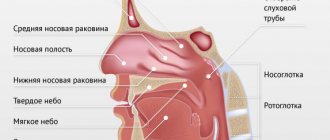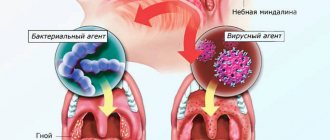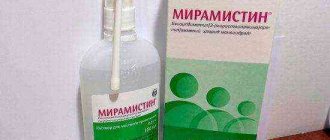A cold is usually accompanied by inflammation of the oropharynx. Therefore, when a person is sick, it is difficult for him to swallow, he has a cough, a sore throat, a runny nose, and a fever. Associated symptoms include discomfort in the muscles and bones, chills, lethargy, and general weakness. The high temperature causes a headache, and swallowing causes severe discomfort in the throat.
If therapeutic measures are not taken in time, the disease will acquire a chronic form, which is characterized by constant and prolonged colds, malaise and weakness.
There are many reasons that can cause a sore throat; in each individual case, only a doctor can prescribe treatment. Make an appointment with an otolaryngologist at the Rossimed clinic to correctly diagnose the disease.
Prices for services
- Consultations
- ENT manipulations
| Services | Price | |||||
| Primary appointment (examination, consultation) with an ENT doctor | 1800 rub. | |||||
| Repeated appointment (examination, consultation) with an ENT doctor | 1500 rub. | |||||
| Appointment (consultation) before washing the tonsils | 1000 rub. | |||||
| Type of manipulation | Price | |||||
| Rinsing the lacunae of the tonsils with the introduction of a medicinal substance | 850 | |||||
| Removal of wax plug 1 side | 700 | |||||
| Rinsing the nasopharynx | 600 | |||||
| Navigating Proetsu ("Cuckoo") | 1 000 | |||||
| Aspiration according to Zonderman | 900 | |||||
| Rinsing the lacunae of the tonsils with the introduction of a medicinal substance | 750 | |||||
| Blowing of the Eustachian tubes according to Politzer | 600 | |||||
| Lubrication of the mucous membrane of the ENT organs, turunda with medicinal substances, insufflation of medicinal powder 1 procedure | 500 | |||||
| Opening a nasal boil | 2 500 | |||||
| Introduction of a medicinal substance into the larynx | 650 | |||||
| Pneumomassage of the eardrum | 500 | |||||
| Stopping nosebleeds with medications | 950 | |||||
| Stopping nosebleeds - anterior tamponade | 1 900 | |||||
| Anemization of the nasal mucosa | 250 | |||||
| Toilet external auditory canal | 650 | |||||
| Removing a foreign body from the pharynx/larynx | 2 250 | |||||
| Removal of a foreign body from the ear, nose | 1 250 | |||||
| Opening a boil of the external auditory canal | 1 900 | |||||
| Puncture of one maxillary sinus | 1 900 | |||||
| Opening of one tonsil cyst | 1 400 | |||||
| Paracentesis of one eardrum | 1 750 | |||||
| Taking a smear from ENT organs | 400 | |||||
| Taking a throat swab for BL (diphtheria bacillus) | 400 | |||||
| Application of medicinal substances into the nasal cavity and ear | 500 | |||||
| Intra-ear compress according to Tsytovich | 600 | |||||
| Non-puncture rinsing of the nasal sinus, 1 side (without the cost of the YAMIK catheter) | 1 900 | |||||
| Intranasal blockade | 900 | |||||
| Catheterization of the auditory tube with anemization and anesthesia | 1 000 | |||||
| Taking histology from ENT organs 1 (one) study, without the cost of histology | 900 | |||||
| OTOSCOPE (without consultation) | 400 | |||||
| RHINOSCOPY (without consultation) | 400 | |||||
| PHARINGOSCOPY (without consultation) | 400 | |||||
| Opening a paratonsillar abscess | 4 900 | |||||
| Parameatal block | 500 | |||||
| Closed reduction of the nasal bones (without the cost of anesthesia) | 7 500 | |||||
| Instrumental sanitation of the nasal cavity | 1 000 | |||||
| Cauterization of the pharyngeal mucosa with drugs | 450 | |||||
| Audiometry | 1 400 | |||||
| Washing the abscess cavity after opening (ENT) | 950 | |||||
| Flushing the maxillary sinus through a catheter | 900 | |||||
| Parameatal block (1 procedure) | 900 | |||||
Make an appointment online
Sign up
Main causes of sore throat
With the onset of cold weather, people increasingly turn to the doctor about colds. During such periods, outbreaks of influenza epidemics are observed. Frequent incidence is observed among people with reduced immunity.
They easily pick up viral and bacterial infections, which are the main cause of discomfort in the throat. Pathogenic microbes enter the mucous membrane of the nasopharynx through airborne droplets or through direct contact with household items, for example, shared dishes, towels, and bed linen.
Patients complain:
- For a sore throat when swallowing.
- Soreness.
- Dry cough.
- Hoarseness of voice.
The cause of such symptoms are toxins produced by bacteria accumulated on the mucous membrane.
However, a sore throat can be caused by vitamin deficiency. In this case, it is necessary to establish proper nutrition. Sometimes it is not possible to restore the deficiency of essential substances through products. In such a situation, the doctor prescribes vitamin complexes.
A sore throat without fever appears as a result of injury to the mucous membrane. However, if an infection penetrates through the damaged areas, then a feverish state will accompany the main symptom.
The cause of discomfort in the larynx can be:
- Dry or air-conditioned air.
- Panic attacks.
- Being in a stuffy room where there is a lot of smoking.
- Injuries caused by sharp objects, such as fish bones.
- Thermal or chemical burns.
In addition, stylohyoid syndrome can cause pain. As well as excessive stress on the vocal cords, for example, when singing or long-term lecturing, in children when screaming and crying.
Sore throat - cold, sore throat or tonsillitis?
A sore throat is a common symptom of a cold (an acute respiratory viral disease). However, a sore throat with a cold lasts one to two days and may go away without treatment. A common symptom of a cold is a runny nose and nasal congestion.
Sore throat, a disease caused by the bacterium streptococcus, is also a common cause of sore throat. With a sore throat, the sore throat is intense, lasts longer and is accompanied by a number of common symptoms.
Tonsillitis is a painful inflammation of the tonsils, which are located at the back of the throat. Also causes a sore throat.
What causes a sore throat during a cold - bacteria or viruses?
Most often, a sore throat during a cold is caused by various viruses and may be accompanied by other symptoms of viral diseases - runny nose, fever, cough, red eyes.
How to treat a sore throat with a cold?
Although there are no medications that directly target the viruses that cause colds, there are treatments that can help relieve a person's cold. Drinking plenty of warm fluids, salt gargles, and taking antipyretic medications help reduce cold symptoms.
Do medications improve the symptoms of a sore throat due to a cold?
Antipyretics relieve cold symptoms and sore throats. But the effectiveness of these drugs should not be exaggerated.
- Nonsteroidal anti-inflammatory drugs such as ibuprofen or naproxen relieve sore throats associated with colds. There are many commercial preparations that contain these substances. We remind you that aspirin should not be given to children to avoid the development of Reye's syndrome, which can cause brain damage and death .
- Various sprays with antiseptics and anesthetics reduce the intensity of sore throat.
- Vasoconstrictor nasal sprays and drops improve the symptoms of sore throat during colds by applying to the back wall of the pharynx. It is not recommended to use them for more than 3 days - they become ineffective and can cause even greater swelling of the mucous membrane
Antibiotics do not need to be used to treat colds and sore throats because all colds are caused by viruses .
How does a sore throat with strep throat differ from a sore throat with a cold?
Inflammation in the pharynx during sore throat is caused by streptococcal bacteria. To become infected with tonsillitis, airborne contact with a patient or carrier of streptococcal infection is necessary. Despite the fact that tonsillitis most often occurs in children aged 5 to 15 years, adults can also get it. To accurately diagnose a sore throat, the attending physician can take a rapid test for streptococcus or send the material for bacterial testing to a laboratory. Most often, the diagnosis is made by a doctor based on the leading symptoms of sore throat - high fever, acute sore throat, white plaque on the pharyngeal mucosa and enlarged regional lymph nodes in the neck.
Why is a sore throat with a sore throat more dangerous than with a cold?
Streptococcal tonsillitis can cause such a serious complication as rheumatism with damage to the heart valves. Therefore, it is very important to start proper treatment of sore throat on time. With proper treatment, the symptoms of sore throat disappear within 10 days.
Is a sore throat different from a sore throat and a cold?
With a sore throat, the pain in the throat is more intense and differs in a number of features
- sudden onset
- loss of appetite
- pain when swallowing
- redness of the tonsils with white plaques
- high fever
Should you seek help from a doctor if you suspect streptococcal sore throat?
On the first day of illness, sore throat with a cold and sore throat can be very similar. If you still suspect the presence of a sore throat, you must definitely consult a doctor to establish the correct diagnosis and carry out therapy.
Treatment for sore throat with sore throat?
For angina, the use of antibiotics is mandatory . Oral antibiotics of the penicillin group are most often prescribed. If you are allergic to these antibiotics, your doctor will select another group. You must strictly follow the prescribed regimen of taking the antibacterial drug, even if you feel better during the first and second days.
Why does the sore throat with streptococcal sore throat not improve?
Sometimes, despite taking medications, the condition of a sore throat does not improve within two to three days. This may indicate the development of complications. A visit to the doctor is necessary to clarify treatment. Be sure to consult a doctor if you have the following symptoms:
- fever for more than 2-3 days while taking antibiotics
- nausea or vomiting
- earache
- severe headache
- neck muscle tension
- the appearance of a skin rash
- cough
- shortness of breath
What is the difference between a sore throat with a cold and a sore throat with tonsillitis?
Sometimes a sore throat occurs due to tonsillitis, an inflammation of the tonsils (lymphatic tissue) in the throat. Tonsillitis can be caused by both viruses and bacteria. The tonsils protect the body from infection through the pharynx, but they themselves can be affected by an infectious agent. When this happens, the affected tonsils cause severe pain.
How do the symptoms of tonsillitis differ from a sore throat due to a cold?
A cold is usually accompanied by symptoms such as runny nose, nasal congestion, and cough. With tonsillitis, there are no these symptoms, but there is swelling of the tonsils and a yellowish coating on them. In addition, the following symptoms occur with tonsillitis:
- difficulty breathing
- fever
- hoarseness of voice
- pain when swallowing
- enlarged lymph nodes in the neck
How to treat sore throat due to tonsillitis?
If tonsillitis is caused by bacterial flora, antibiotics are necessary. The decision is made by the attending physician. Antibiotics are useless for viral infections. In this case, you should adhere to the tactics of treating sore throat with a cold. In any case, if you have a sore throat, you should follow the general recommendations:
- be at rest
- drink plenty of warm liquid
- eat soft, warm foods, avoid rough and spicy foods
- use medicinal aerosols
- If you have a fever, use antipyretic drugs
With frequent exacerbations of tonsillitis, it is necessary to consult a doctor to decide on tonsillectomy (removal of the tonsils).
For all questions related to the pathology of the ENT organs, you can contact the experienced ENT doctors of the ANDROMEDA Clinic.
Otorhinolaryngologist of the highest category Morenko M.V.
Why does your throat hurt when you don't have a fever?
Hyperthermia is usually present with viral and bacterial infections and colds. The cause is such pathologies as:
- Diphtheria.
- Laryngitis.
- Scarlet fever.
With angina, patients may feel nauseous, loose stools, experience diarrhea, fever, and aching bones and muscles. The reason lies in the general intoxication of the body caused by the accumulation of pus in the retropharyngeal region or an abscess.
Chronic tonsillitis or pharyngitis is not always accompanied by fever.
However, there are cases when patients complain that they have a sore throat for no apparent reason. In such a situation, you should ask what pharmacological drugs have been taken recently. After all, pain can be a side effect of a number of medications.
Some people cannot tolerate tobacco smoke. Even one breath is enough to start coughing and tickling. The reaction to atmospheric pollution by chemical vapors also manifests itself. Therefore, people who work in hazardous industrial conditions, as well as those living in environmentally unfavorable areas, complain that they have a sore throat.
Another reason that causes pain that radiates to the ear is neuralgia of the upper larynx, as well as osteochondrosis of the neck. Similar signs also occur in the presence of neoplasms.
Having considered the various manifestations of sore throat and the causes of its occurrence, it is worth paying attention to the provoking factors. Among which doctors highlight:
- Smoking, including passive smoking.
- Passion for oral sex.
- Decreased protective function. If an adult’s body is able to cope with an infection, then a child with an unformed immune system is easily susceptible to the disease.
- Allergy. Unpleasant sensations in the throat appear mainly in the morning.
In addition, the throat may hurt in patients with HIV and diabetes. The cause is often chemotherapy and hormonal treatment.
Make an appointment online
Sign up
Causes of red throat
Redness of the throat may be due to factors unrelated to infection2:
- Mechanical injuries to the mucous membrane of the pharynx due to solid food and bones.
- Eating hot food that can cause thermal burn2.
- Irritation or burn of the pharynx with chemicals (acids, alkalis, alcohol-containing liquids)2.
- Eating excessively spicy foods (hot pepper, ginger, horseradish, mustard can cause irritation of the mucous membranes).
- Inhalation of tobacco smoke, dust or air contaminated with mechanical and chemical impurities.
Eating food containing red food dyes. In this case, the throat is red, but does not hurt.
Up to contents
Associated symptoms
Each pathology is characterized by a certain set of symptoms. So, with a cold and acute respiratory infections, in addition to fever and sore throat, a runny nose and cough, nasal congestion and difficulty breathing can be observed.
Associated symptoms of ARVI and influenza are:
- General weakness.
- Muscle, joint and headaches.
- Hyperthermia.
When infected with viruses, a rash on the skin, enlargement of the spleen and lymph nodes in the neck and armpits may occur.
Diagnosis of diseases
The choice of treatment tactics depends on the type of pathology. Therefore, it is necessary to carefully examine the patient. Diagnosis begins with collecting anamnesis. The doctor asks questions that help determine the symptoms characteristic of a particular disease. He is interested:
- The timing of the appearance of the first signs of illness.
- The time when the severity of symptoms increases. This could be at night or in the morning.
- Which side of the throat is the pain more intense - the right or the left? This is usually how acute pharyngitis manifests itself.
- The presence of hoarseness and changes in voice may indicate sore throat or laryngitis.
If only the right or left side hurts, then the presence of neoplasms can be suspected. In babies, the cause may be teething.
Differential diagnosis is necessary to identify pathologies such as Hilger's syndrome, gastroesophageal reflex, dysfunction of the thyroid gland and adrenal glands, cervical osteochondrosis, esophageal varicose veins.
Often a sore throat appears during myocardial infarction.
The second stage of diagnosis involves examining the patient. The doctor assesses the condition of the mucous membranes of the nose and mouth. It can detect plaque, swelling, redness, signs of injury, and neoplasms.
If an infection is suspected, a swab is taken and sent for testing to a laboratory.
A clinical blood test can reveal the inflammatory process.
If there are complaints of pain radiating to the ear, otoscopy is prescribed.
When to see a doctor
In addition, qualified medical assistance will be required:
- When there are no signs of a cold, but the pain is intense and does not go away for two days.
- The temperature rises sharply and reaches critical levels.
- Purulent formations are visible on the mucous membranes of the throat.
- If the changed voice is not restored within 2 weeks.
An ambulance will be called if the intensity of the pain does not allow you to swallow saliva or the swelling of the mucous membranes is severe, which causes difficulty breathing, in which extraneous noises in the form of whistling and wheezing are heard.
A little anatomy
The pharynx is part of the respiratory tract and digestive tract. It contains a whole complex of lymphoid formations called the Pirogov-Waldeyer pharyngeal ring. The ring includes the palatine, pharyngeal, lingual, tubal tonsils, as well as lymphoid granules and ridges that are located on the lateral walls of the pharynx.
The tissues of the pharynx are penetrated by a huge number of blood vessels. Their superficial location provides warming or cooling of the air inhaled through the mouth and nose. In contact with the mucous membrane, the air is cleared of dust, chemical impurities and various microorganisms. Dust particles, substances and microbes settled on the mucous membrane irritate it, which sometimes causes inflammation and redness of the throat1.
Up to contents










